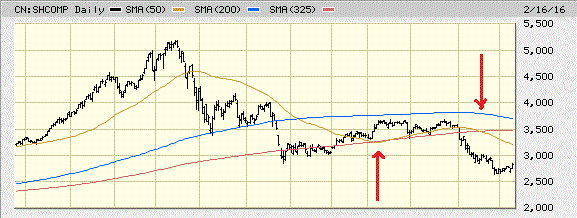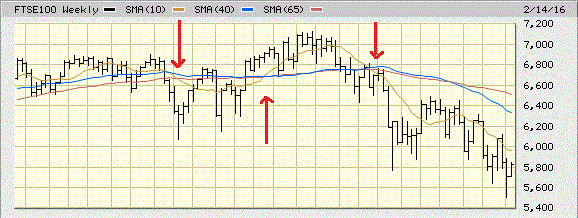Using The Double-Death Cross For Improved Sell Signals
All traders are aware of the Death-Cross (when the 50-day moving average falls below the 200-day moving average) as a sell signal. Anyone who has been an active trader since 2008 also knows this frequently provides false signals and has ceased to be useful for its intended purpose. It is not unknown for something like this to happen with indicators. When it does, some modification of the old signal is needed or it has to be abandoned altogether.
There is a simple modification that can be done for the Death-Cross, which can be called the Double-Death Cross. This is based on the idea that if two moving averages don’t work, then an obvious solution is to try three, with the third one acting as confirmation that the signal given by the first two is valid. But what should the third one be? It turns out that the 325-day (or 65-week) moving average is an excellent option. While this may seem like an odd choice, it isn’t. Traditionally, commodity traders used the 65-week as the dividing point between a bull and bear market. It turns out it works quite well for stocks too.
So when the 50-day falls below the 200-day (or the 10-week below the 40-week) moving average, wait until there is a further cross of the 325-day (65-week) until you decide it’s a good time to take short positions. In strong bull markets, the distance between the 200-day and 325-day can be considerable, so the confirming cross is unlikely. After the bull market has been waning for a while and stock prices have been moving sideways, these two moving averages will start to move closer and the 50-day cross of the 325-day becomes more likely.
An example of when the 50-day/325-day cross failed to take place recently took place on the Nasdaq in the United States and the Nikkei in Japan. The red lines point to where the 50-day failed to confirm the 200-day cross by not falling below the 325-day and the market then headed back up and when the signal was finally confirmed later on.


Note, in both cases, that the 200-day moving average was still moving up during the failure, but had started moving down when the confirmation was successful. This is an additional useful piece of information and one of several reasons why the 200-day (40-week) moving average needs to be kept to provide a complete picture of what is taking place (this will be discussed further in future articles).
While the Double-Death Cross is a major improvement over the Death-Cross, it still has its limitations. Neither provides an early signal to catch the initial major move down in the case of a bubble collapsing such as was the case in the Shanghai Composite in China last summer. Technical indicators, such as the RSI, MACD, and DMI should be used in this situation (they can also be helpful in conjunction with the Double-Death Cross). It is nevertheless useful for the subsequent moves down as the bubble deflates further.

The Double-Death Cross is also subject to failure like all indicators. An example of this was in the FTSE100 in the UK in the last two years. This index began to fall apart, but was resurrected one last time by central bank lose money policy as this weekly chart indicates. The confirmation was made, but then reversed and the 40-week moving average, which had begun to fall, started rising again. A more definitive cross was made a few months later.

While the Double-Death Cross is advantageous for trading stocks, it is far more useful when used with a top down approach. First, check and see what it is saying about the market as a whole, a sector, and then look at individual stocks. It should be kept in mind that it is an early warning system of a bear market and the final confirmation is when the moving averages are properly aligned with the longer-term ones on top and the shorter-term ones below them in sequence.
All references to moving averages used in this article are for simple moving averages.
None.




Great read, thanks.
Thanks! There will be followup articles explaining more.